'Dryden' Apple-1 computer
In my private collection are these original Apple-1 computer:
'#1 Copson Apple‑1',
'#2 Dryden Apple‑1',
'#3 Duston-2 Apple‑1',
'#4 Heathcott / Lee Apple‑1',
'#5 Reinemer Apple‑1',
'#6 Flatiron Apple‑1',
'#7 Burr Apple‑1',
'#8 Dreike Apple‑1',
'#9 Scardino Apple‑1'.
and 1,000+ a other vintage computer. Including the very first prototype of the Kenbak-1 computer. Please contact me, if you have computers made before 1984 to offer.
The Dryden Apple-1 is listed in the Apple-1 Registry as #14.
History of the Dryden Apple-1
It is an original and working Apple-1 computer from the 1st batch.
In 2017, this Apple-1 was offered by the first owner via auction after 41 years in his hands.
With the computer, there were a keyboard in a beautiful wooden case from 1976, various cassettes from 1976, original manuals and a 19-inch case in which the owner had installed the Apple-1.
As it is often the case, a one-of-a-kind Apple-1 immediately stands out from the crowd with its wooden case and a keyboard.
There is also a correspondence with Apple, which is unique. In 1977, the company offered all owners of an Apple-1 the opportunity to trade their computers for an Apple II for an additional fee. A trade-in, so to speak.
The first owner wanted to take advantage of this offer in 1979, but no one at Apple remembered this offer, which is why this beautiful Apple-1 has been preserved.
On the back, there is a round stamp with the number 7 and 01-0073 is handwritten on the back. For more information on theories of this number, see the Copson Apple-1.
All components are as original as delivered in 1976, what is rarely the case. It is often the situation of components that had to be replaced or even motherboards that were assembled decades later. In this case, only 2 IC sockets have been replaced by the first owner.
Originals from 1976 are available as replacements. For me, this Apple-1 is in its original state with the modifications. After all, the Apple-1 was a home computer that appealed primarily to hobbyists.
Every Apple-1 has a prototype area, in which components could be soldered in, which many owners used. The components added to the Dryden Apple-1 and the additional wiring show the owner's deep understanding of this computer.
Many current Apple-1 owners have reversed the changes and enhancements made by first-time owners to make the computer look more "original". Many collectors, experts and museums see it differently, since these changes are part of the history of the device and contribute to its authenticity. If I should pass this Apple-1 on, it is up to the new owner to decide for himself.
After 30 minutes of work, the Apple-1 could look like it had just been taken out of the box. In my opinion, these additional components are a historical part of the object and contribute to its authenticity and uniqueness.
On some pictures, you can see an additional electrolytic capacitor piggyback on an original electrolytic capacitor. Those are old pictures. The first owner removed this additional component, which doesn't affect the functionality.
The condition of this Apple-1 is very good. There were some people that spoke about this Apple-1 without having had it in their own hands. If everything was dismantled, this Apple-1 would be an outstanding example in the eyes of people. Museums and many collectors see such demolitions as controversial.
Everything is in very good condition and the computer is still working. The Apple-1 was tested by Mr. Rudolf Brandstötter in the run-up to the auction. Alongside Corey Cohen, Mr. Brandstötter, who has auctioned off two Apple-1, is one of the experts who have already sold many units of this computer. It was turned on and tested for the auction.
In November 2017, other successful tests with this Apple-1 took place.
On the back is the serial number 01-0073 handwritten by Steve Jobs.
The acquisition
The auction was unusual in all respects and its price, when compared to other Apple-1, was incredibly low. The auction took place near me and I was actually only present to buy a beautiful rocket engine as an object for my office. The expected purchase price of the Dryden Apple-1 was very high. I had checked the Apple-1 personally in the auction house and I liked very much what I had seen. The auction started and immediately the first bid was there. Then nothing happened for a long time and the auction faltered unusually. When the auctioneer called "going once, going twice, going twice," I raised my bidding card reflexively. Photographers were there immediately. Again, an unusually long time passed. In the meantime, I was considering a maximum bid. Incredibly, there was no further bidding.
After the auction, I had accidentally contacted two interested parties, who for various reasons did not bid during the auction, but called me offering enormous sums of money. Many owners sell their Apple-1 after a short time and consider the historically valuable device as a fixed asset. Anyway, I'd like to keep my Apple-1 for now.
Quickly there were prophecies of doom and hasty statements, without knowing the reasons for the low revenue. All high prices would only be due to a hype about Steve Jobs and that would be over now.
The opposite happened.
In the same year of 2017, some Apple-1 were auctioned off for three to four times the price. In addition, some of them were offered on the private market and nothing could be done for less than US$350.000.
Soon after the auction, I received my first offer, which was in the now common price range. But as I said before, I am happy to own this computer and I don't want to turn it into gold. I have already given my first Apple-1 to the Deutsches Museum München.
More and more Apple-1 are going to museums. In addition, there are collectors who probably won't give up on their Apple-1 for life. In a few years the market will dry out.
The acquisition will be more difficult and expensive with time. There will always be exceptions and luck for the buyer.
For the time being, this Apple-1 is stored in a bank safe. The Dryden Apple-1 should either go to its own museum or a traveling exhibition.
Exhibition at ZKM Karlsruhe, Germany
From July 14, 2018 till February 10, 2019 at ZKM, Center for art and media, Lorenzstraße 19, 76135 Karlsruhe. ZKM Website (German only, please use online translator).
Exhibition was called „Kunst in Bewegung. 100 Meisterwerke mit und durch Medien.“ (Art in motion. 100 masterpieces with and through media).
A custom box was built to protect the mainboard, cassette interface and the keyboard. By special transport it was going to Karlsruhe in June 2018.
The Apple-1 is still in the state first owner of 1976. The first owner added some parts and replaces a socket. I believe after 40+ years this is part of the history and belongs to the board. I preserve this state. Even no cleaning was done. And that’s the way every museum like/want it! Restoration would only done if the artifact is in danger or badly damaged. But this Apple-1 is in working condition and all parts are original. Nothing is changed, no components are added/replaced later (except the keyboard socket and the added parts by first owner in the 70’s).
The in 1976 added electronic are inverters for using a keyboard. The keyboard is homemade like every keyboard used for an Apple-1 in the 70’s. Apple did not offer a keyboard.
The added components (inverter ICs) were necessary to use some keyboards in 1976. Many Apple-1 were modified for auctions in the past. Those added parts were removed and a 1977 or even later Apple II keyboard was attached. The Dryden Apple-1 is still in the 1976 state including the keyboard. Not everyone agree that it is worth to destroy the history of the Apple-1 mainboard and remove 1976 parts necessary to use some 1976 keyboard just to make the mainboard looking “clean” and add much later produced keyboards.
Pictures
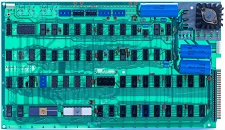 +
Dryden Apple-1
+
Dryden Apple-1
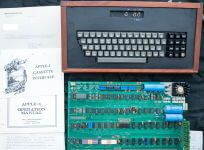 +
Dryden Apple-1
+
Dryden Apple-1
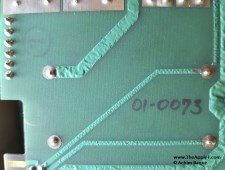 +
Dryden Apple-1 back side
+
Dryden Apple-1 back side
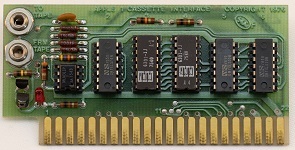 +
ACI front
+
ACI front
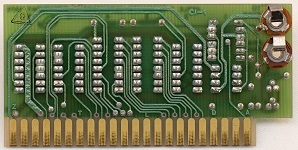 +
ACI back
+
ACI back
 +
Keyboard
+
Keyboard
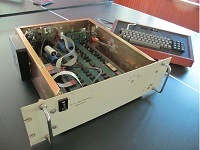 +
19" rack
+
19" rack
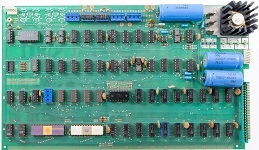 +
Number on the back
+
Number on the back
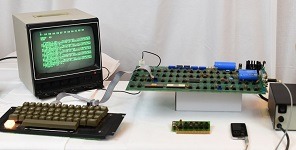 +
Working Apple-1
+
Working Apple-1
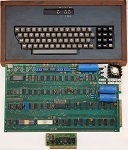 +
Keyboard, mainboard and ACI
+
Keyboard, mainboard and ACI
 +
Keyboard
+
Keyboard
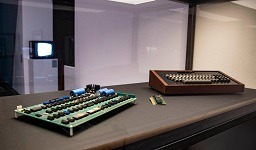 +
At exhibition in Karlsruhe/Germany
+
At exhibition in Karlsruhe/Germany
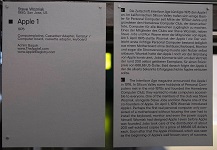 +
At exhibition in Karlsruhe/Germany
+
At exhibition in Karlsruhe/Germany
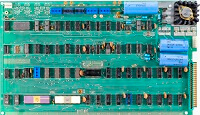 +
Dryden Apple-1
+
Dryden Apple-1
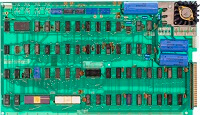 +
Dryden Apple-1
+
Dryden Apple-1
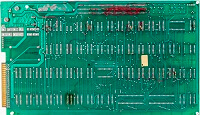 +
Dryden Apple-1
+
Dryden Apple-1
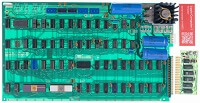 +
Dryden Apple-1
+
Dryden Apple-1
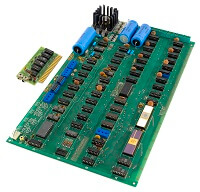 +
Dryden Apple-1
+
Dryden Apple-1
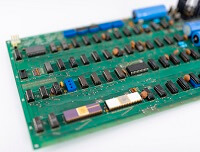 +
Dryden Apple-1
+
Dryden Apple-1
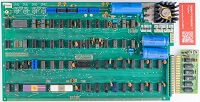 +
Dryden Apple-1
+
Dryden Apple-1